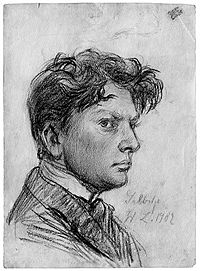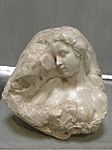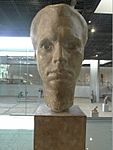Wilhelm Lehmbruck facts for kids
Quick facts for kids
Wilhelm Lehmbruck
|
|
|---|---|

Wilhelm Lehmbruck Self-portrait (1902)
|
|
| Born |
Wilhelm Lehmbruck
4 January 1881 Meiderich (part of Duisburg since 1905), German Empire
|
| Died | 25 March 1919 (aged 38) |
| Nationality | German |
| Known for | Sculpture |
| Movement | Realism, Expressionism |
Wilhelm Lehmbruck (born January 4, 1881 – died March 25, 1919) was a German sculptor. He was one of the most important artists of his time. His work was inspired by realism and expressionism.
About Wilhelm Lehmbruck
Wilhelm Lehmbruck was born in Meiderich, which is now part of Duisburg, Germany. He was the fourth of eight children in his family. His father was a miner.
He was able to study art at the School of Applied Arts in Düsseldorf. This was possible because he received money from the city. In 1899, he started earning a living by drawing pictures for science books.
He continued his training at the Kunstakademie Düsseldorf from 1901 to 1906. After finishing his studies, Lehmbruck became an independent artist in Düsseldorf. He showed his art for the first time in Cologne in 1906.
Lehmbruck was very impressed by the sculptures of Auguste Rodin. He traveled to England, Italy, the Netherlands, and Paris to see more art. In 1907, he married Anita Kaufmann, and they had three sons.
In 1912, Lehmbruck showed his art at the Folkwang Museum in Hagen with Egon Schiele. Two years later, in 1914, he had his first solo art show in Paris. He also showed his work at a big art event called the Grand Palais in Paris. From 1910 to 1914, he lived in Paris. He often visited the Café du Dôme. There, he met other famous sculptors like Modigliani, Brâncuși, and Archipenko.
During World War I, he worked as a paramedic in a military hospital in Berlin. The sadness and suffering he saw there deeply affected him. These feelings are shown in his later sculptures, like Fallen Man (1915–16). He struggled with deep sadness and moved to Zürich at the end of 1916 to get away from the war. In early 1919, he was chosen to be a member of the Prussian Academy of Arts in Berlin.
His Sculptures
Lehmbruck's sculptures mostly focus on the human body. His art was influenced by Naturalism and Expressionism. Naturalism means making art look very real, like what you see in life. Expressionism means showing feelings and emotions more than just what things look like.
The famous architect Ludwig Mies van der Rohe often placed Lehmbruck's sculptures in his buildings. He also used sculptures by Aristide Maillol.
Where to See His Art
The Lehmbruck Museum in Duisburg, Germany, has a large collection of his work. It includes about 100 sculptures, 40 paintings, and many drawings and prints. The museum is named after Wilhelm Lehmbruck. His son, Manfred Lehmbruck (1913–1992), helped design the museum.
Other museums around the world also have Wilhelm Lehmbruck's art. These include the Honolulu Museum of Art, the Museum of Modern Art in New York City, and the National Gallery of Art in Washington D.C. You can also find his works at the Städel Museum in Frankfurt, Germany, the Neue Nationalgalerie in Berlin, and the Tate Gallery in London, England. One of his sculptures can even be seen in the Villa Tugendhat.
Gallery
See also
 In Spanish: Wilhelm Lehmbruck para niños Lehmbruck-Museum
In Spanish: Wilhelm Lehmbruck para niños Lehmbruck-Museum



